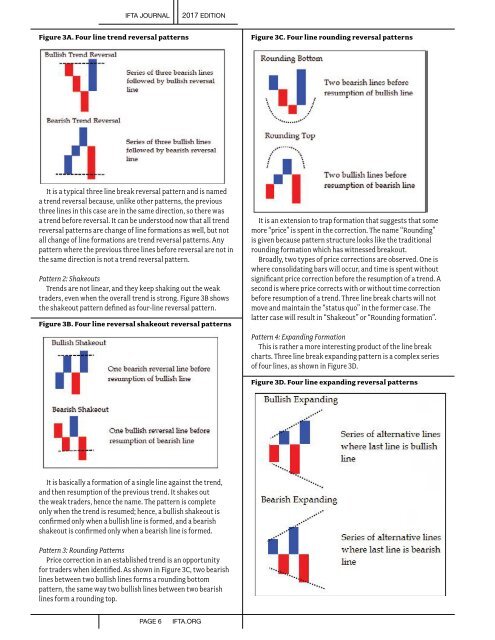You also want an ePaper? Increase the reach of your titles
YUMPU automatically turns print PDFs into web optimized ePapers that Google loves.
IFTA JOURNAL<br />
2017 EDITION<br />
Figure 3A. Four line trend reversal patterns<br />
Figure 3C. Four line rounding reversal patterns<br />
It is a typical three line break reversal pattern and is named<br />
a trend reversal because, unlike other patterns, the previous<br />
three lines in this case are in the same direction, so there was<br />
a trend before reversal. It can be understood now that all trend<br />
reversal patterns are change of line formations as well, but not<br />
all change of line formations are trend reversal patterns. Any<br />
pattern where the previous three lines before reversal are not in<br />
the same direction is not a trend reversal pattern.<br />
Pattern 2: Shakeouts<br />
Trends are not linear, and they keep shaking out the weak<br />
traders, even when the overall trend is strong. Figure 3B shows<br />
the shakeout pattern defined as four-line reversal pattern.<br />
Figure 3B. Four line reversal shakeout reversal patterns<br />
It is an extension to trap formation that suggests that some<br />
more “price” is spent in the correction. The name “Rounding”<br />
is given because pattern structure looks like the traditional<br />
rounding formation which has witnessed breakout.<br />
Broadly, two types of price corrections are observed. One is<br />
where consolidating bars will occur, and time is spent without<br />
significant price correction before the resumption of a trend. A<br />
second is where price corrects with or without time correction<br />
before resumption of a trend. Three line break charts will not<br />
move and maintain the “status quo” in the former case. The<br />
latter case will result in “Shakeout” or “Rounding formation”.<br />
Pattern 4: Expanding Formation<br />
This is rather a more interesting product of the line break<br />
charts. Three line break expanding pattern is a complex series<br />
of four lines, as shown in Figure 3D.<br />
Figure 3D. Four line expanding reversal patterns<br />
It is basically a formation of a single line against the trend,<br />
and then resumption of the previous trend. It shakes out<br />
the weak traders, hence the name. The pattern is complete<br />
only when the trend is resumed; hence, a bullish shakeout is<br />
confirmed only when a bullish line is formed, and a bearish<br />
shakeout is confirmed only when a bearish line is formed.<br />
Pattern 3: Rounding Patterns<br />
Price correction in an established trend is an opportunity<br />
for traders when identified. As shown in Figure 3C, two bearish<br />
lines between two bullish lines forms a rounding bottom<br />
pattern, the same way two bullish lines between two bearish<br />
lines form a rounding top.<br />
PAGE 6<br />
IFTA.ORG


